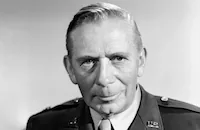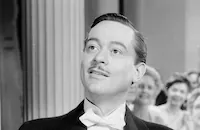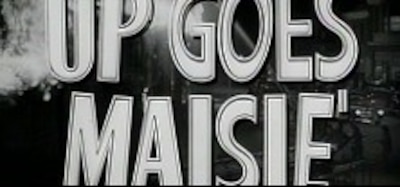Up Goes Maisie

Brief Synopsis
Cast & Crew
Harry Beaumont
Ann Sothern
George Murphy
Hillary Brooke
Horace Mcnally
Ray Collins
Film Details
Technical Specs

Synopsis
After graduating from the Benson Business School in Los Angeles, Maisie Ravier is ready to begin her search for work as a secretary. Though she is immediately offered a job by Mr. Benson, the head of the school, Maisie declines because she knows that Benson is only interested in her for her good looks. When Benson tries to pressure Maisie into accepting the job and makes a pass at her, she knocks him to the ground and storms out of his office. After attending a series of disappointing job interviews, all of which end abruptly when she is made to feel like an object of sexual desire, Maisie decides to alter her wardrobe and hair to appear more studious and less attractive. The disguise proves successful as Maisie wins a job as a secretary to Joseph Morton, an inventor working on a secret design for a high-speed helicopter. Soon after Joseph hires Maisie, he learns that she used to work at an aircraft manufacturing company, and thus knows a great deal about the technical aspects of aviation. Once he is certain that Maisie can be trusted, Joseph takes her to the secret plant where he and his pals, Mitch O'Hara, Tim Kingby and Bill Stuart, are working on the helicopter. Unknown to Joseph, Kingby is spying on the operation for J. G. Nuboult, the financier of the project. Nuboult, his daughter Barbara and others are secretly building a copy of Joseph's helicopter at another location. Because Joseph is uncomfortable accepting Nuboult's money and feels beholden to Barbara for the arrangement, he tries to get new financing from Seattle tycoon Floyd Hendrickson. Hendrickson agrees to visit Los Angeles in a week's time to inspect the helicopter, and Joseph rushes to complete the project. When Kingby and Barbara learn about Hendrickson's visit, they work on a plan to sabotage Joseph's demonstration. At the same time, Joseph and Maisie, who have sparked a romance, announce their engagement. Fearing that Maisie's nosiness could threaten their plans, Kingby and Barbara conjure up a plan to humiliate her in public and cause a rift in her relationship with Joseph. As part of the plan, Barbara invites Maisie to a high society function and slips a drug into her drink. The drug makes Maisie appear extremely drunk, and she jumps into a pool with her clothes on, just as a photographer snaps her picture. When Maisie sees the picture in the newspaper the following day, she decides to go into hiding. After assigning a private detective to find Maisie, Joseph forges ahead with his plans to demonstrate the helicopter at the Pasadena Rose Bowl. The night before the demonstration, however, Joseph goes to Seattle to get Hendrickson, and Kingby sets fire to the plant. Maisie hears about the fire on a police radio, and when she arrives at the plant, she finds evidence that Nuboult and Kingby have been building a second helicopter. Maisie, Bill and Mitch secretly follow Kingby to the warehouse at which the second helicopter was manufactured, and overhear Kingby and Nuboult's plan to demonstrate the duplicate helicopter for their own investor. Late that night, Maisie, Bill and Mitch sneak into the warehouse and steal the helicopter. Maisie flies the helicopter to the Rose Bowl, and arrives just in time to show it to Hendrickson, who offers to back Joseph's project. Joseph and Maisie celebrate with a kiss, and resume their plans to marry.

Director

Harry Beaumont
Cast

Ann Sothern

George Murphy

Hillary Brooke

Horace Mcnally

Ray Collins
Jeff York

Paul Harvey
Murray Alper
Lewis Howard
Jack Davis
Gloria Grafton

John Eldredge
Garry Owen
Jack Shutta
Nolan Leary
Edgar Dearing
Celia Travers
Mary Jane French
Katharine Booth
Barbara Billingsley

Tim Murdock
Dorothy Vaughn
Robert E. O'connor
Charles Murray Jr.

Lee Phelps

Glen Strange
Ernie Adams
Pat Davis
Edith Clinton
Gwen Crawford
Louise Lang
Roy Butler
Cameron Grant

James Davis
Ben Moselle
Marjorie Davies
Connie Weiler
Sondra Rodgers
John Vosper
Ethel Tobin
Ted Jacques
Bob Duncan
Florence Stevens

Howard Mitchell
Crew
Richard Duce
James Z. Flaster
Cedric Gibbons
A. Arnold Gillespie
Irving Glassberg
George Haight
Irene
Lowell S. Kinsall
Standish J. Lambert
Leo Linder
M. J. Maclaughlin
Ralph A. Pender
Robert Planck
George Richelavie
Thelma Robinson
Arthur Rose
Douglas Shearer
Robert W. Shirley
David Snell
Newell Sparks
Herbert Stahlberg
William Steinkamp
Michael Steinore
Irvine Warburton
Herman Webber
Don T. Whitmer
John A. Williams
Edwin B. Willis

Film Details
Technical Specs

Articles
Up Goes Maisie
By Violet LeVoit

Up Goes Maisie
TCM Remembers - Ann Sothern
TCM Remembers - Ann Sothern
Quotes
Trivia
Notes
This was one of many films in M-G-M's "Maisie" series. For more information on the series, consult the Series Index and the entry for Maisie in AFI Catalog of Feature Films, 1931-40; F3.2662.















